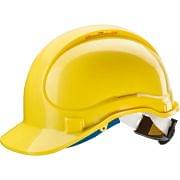Work helmets
Safety at work is a top priority in machine shops, where the risks are many and potentially very serious. Work helmets are one of the most important tools for protecting workers from head injuries.
Hard hats are personal protective equipment (PPE) designed to protect workers' heads from impacts, falling objects, and other potential injuries. They are mandatory in many sectors, including machine shops, where the risk of head injury is particularly high.
Work helmets are made of durable materials such as high-density polyethylene (HDPE) or fibreglass, which offer excellent protection without compromising comfort. They are designed to be robust, durable and capable of absorbing the energy of an impact.
Helmets are designed to offer optimal protection against impact. When an object falls on a worker's head, the helmet distributes the impact over a wider area, reducing the force reaching the skull. This is essential in an environment such as a machine shop, where tools and spare parts can fall accidentally.
In many machine shops, workers are exposed to chemicals that can damage the skin and eyes. Some work helmets are designed to resist these chemicals, offering additional protection against accidental splashes and harmful vapours.
In machine shops where welding or cutting operations take place, sparks are a significant hazard. Work helmets with visors can offer protection not only against impacts, but also against sparks and other flying debris.
Using work helmets correctly is crucial to ensure maximum protection:
- Choosing the Right Helmet
Choosing the right hard hat depends on the type of work and the specific hazards present in the machine shop. It is important to choose a hard hat that complies with safety standards, such as those set by European (EN 397) or international (ANSI/ISEA Z89.1) standards.
- Helmet Adjustment
A helmet must be correctly adjusted to fit the worker's head. The inner band must be adjusted to ensure a secure and comfortable fit. A helmet that moves or falls easily does not offer adequate protection.
- Maintenance and Replacement
Work helmets should be inspected regularly for damage or signs of wear. Any cracks, dents or other visible damage indicate that the helmet must be replaced. Even if the helmet appears to be in good condition, it is advisable to replace it after a period of time to ensure that it retains its protective properties.
Frequently Asked Questions about Hardhats
How long does a work helmet last?
Work helmets generally last about 5 years, although this may vary depending on use and working conditions. It is important to inspect the helmet regularly and replace it if it shows signs of wear or damage.
Are hard hats mandatory?
In many jurisdictions, the use of hard hats is mandatory in environments where there is a risk of head injury. Specific regulations may vary, so it is important to know and follow local laws and company policies.
How do I choose the right size?
Work helmets are generally adjustable to fit different head sizes. However, it is important to try on the helmet and adjust it correctly to ensure that it offers a secure and comfortable fit.
Work helmets are an essential component of safety in machine shops. They offer protection against a variety of hazards, improving safety and efficiency at work. With the right information and proper maintenance, hard hats can make the difference between a safe and unsafe working environment.


